Page 228 of 308
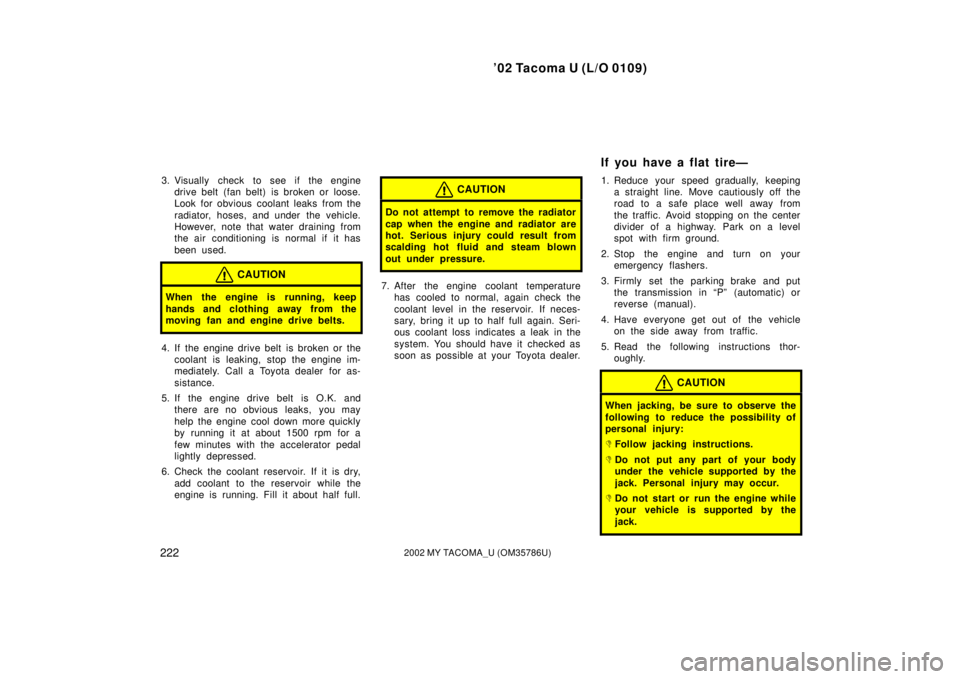
’02 Tacoma U (L/O 0109)
2222002 MY TACOMA_U (OM35786U)
3. Visually check to see if the enginedrive belt (fan belt) is broken or loose.
Look for obvious coolant leaks from the
radiator, hoses, and under the vehicle.
However, note that water draining from
the air conditioning is normal if it has
been used.
CAUTION
When the engine is running, keep
hands and clothing away from the
moving fan and engine drive belts.
4. If the engine drive belt is broken or thecoolant is leaking, stop the engine im-
mediately. Call a Toyota dealer for as-
sistance.
5. If the engine drive belt is O.K. and there are no obvious leaks, you may
help the engine cool down more quickly
by running it at about 1500 rpm for a
few minutes with the accelerator pedal
lightly depressed.
6. Check the coolant reservoir. If it is dry, add coolant to the reservoir while the
engine is running. Fill it about half full.
CAUTION
Do not attempt to remove the radiator
cap when the engine and radiator are
hot. Serious injury could result from
scalding hot fluid and steam blown
out under pressure.
7. After the engine coolant temperaturehas cooled to normal, again check the
coolant level in the reservoir. If neces-
sary, bring it up to half full again. Seri-
ous coolant loss indicates a leak in the
system. You s hould have it checked as
soon as possible at your Toyota dealer. 1. Reduce your speed gradually, keeping
a straight line. Move cautiously off the
road to a safe place well away from
the traffic. Avoid stopping on the center
divider of a highway. Park on a level
spot with firm ground.
2. Stop the engine and turn on your emergency flashers.
3. Firmly set the parking brake and put the transmission in “P” (automatic) or
reverse (manual).
4. Have everyone get out of the vehicle on the side away from traffic.
5. Read the following instructions thor- oughly.
CAUTION
When jacking, be sure to observe the
following to reduce the possibility of
personal injury:
�Follow jacking instructions.
�Do not put any part of your body
under the vehicle supported by the
jack. Personal injury may occur.
�Do not start or run the engine while
your vehicle is supported by the
jack.
If you have a flat tire—
Page 229 of 308
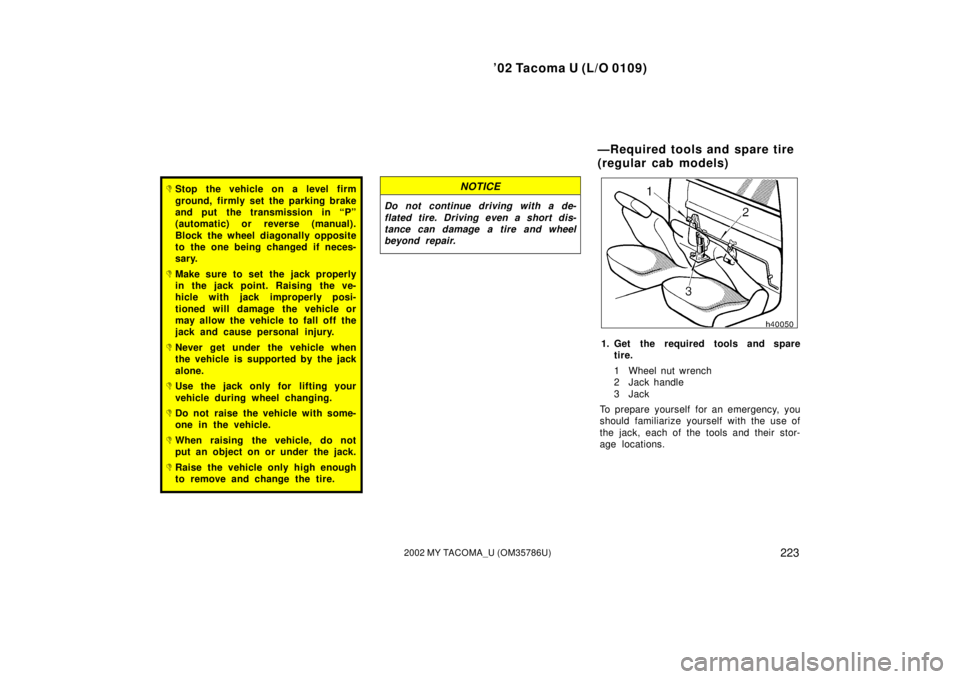
’02 Tacoma U (L/O 0109)
2232002 MY TACOMA_U (OM35786U)
�Stop the vehicle on a level firm
ground, firmly set the parking brake
and put the transmission in “P”
(automatic) or reverse (manual).
Block the wheel diagonally opposite
to the one being changed if neces-
sary.
�Make sure to set the jack properly
in the jack point. Raising the ve-
hicle with jack improperly posi-
tioned will damage the vehicle or
may allow the vehicle to fall off the
jack and cause personal injury.
�Never get under the vehicle when
the vehicle is supported by the jack
alone.
�Use the jack only for lifting your
vehicle during wheel changing.
�Do not raise the vehicle with some-
one in the vehicle.
�When raising the vehicle, do not
put an object on or under the jack.
�Raise the vehicle only high enough
to remove and change the tire.
NOTICE
Do not continue driving with a de-
flated tire. Driving even a short dis-
tance can damage a tire and wheel
beyond repair.
1. Get the required tools and sparetire.
1 Wheel nut wrench
2 Jack handle
3Jack
To prepare yourself for an emergency, you
should fam iliarize yourself with the use of
the jack, each of the tools and their stor-
age locations.
—Required tools and spare tire
(regular cab models)
Page 239 of 308
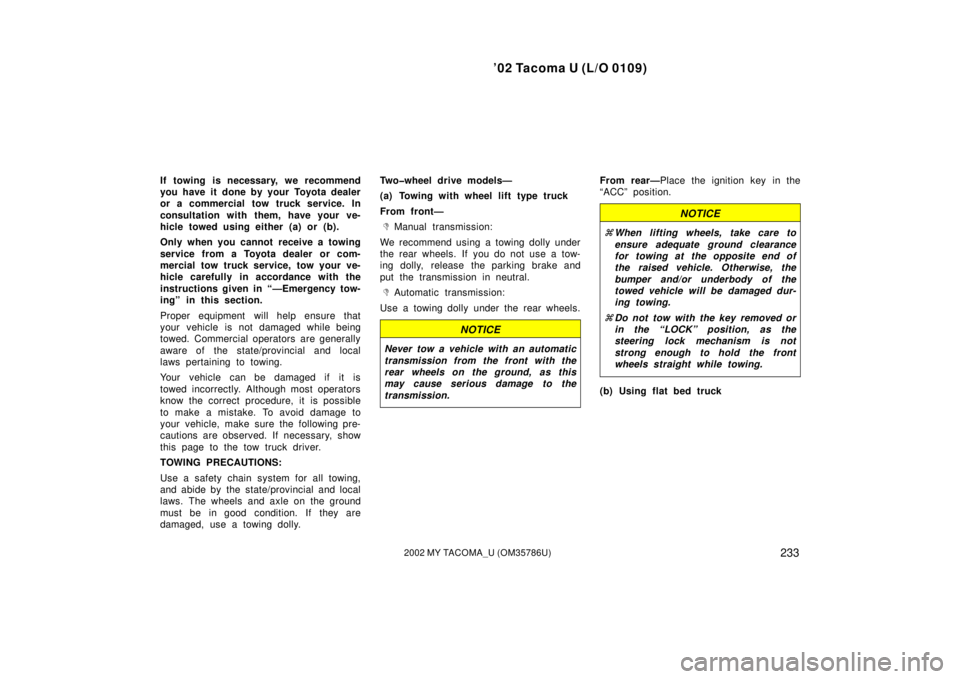
’02 Tacoma U (L/O 0109)
2332002 MY TACOMA_U (OM35786U)
If towing is necessary, we recommend
you have it done by your Toyota dealer
or a commercial tow truck service. In
consultation with them, have your ve-
hicle towed using either (a) or (b).
Only when you cannot receive a towing
service from a Toyota dealer or com-
mercial tow truck service, tow your ve-
hicle carefully in accordance with the
instructions given in “—Emergency tow-
ing” in this section.
Proper equipment will help ensure that
your vehicle is not damaged while being
towed. Commercial operators are generally
aware of the state/provincial and local
laws pertaining to towing.
Your vehicle can be damaged if it is
towed incorrectly. Although most operators
know the correct procedure, it is possible
to make a mistake. To avoid damage to
your vehicle, make sure the following pre-
cautions are observed. If necessary, show
this page to the tow truck driver.
TOWING PRECAUTIONS:
Use a safety chain system for all towing,
and abide by the state/provincial and local
laws. The wheels and axle on the ground
must be in good condition. If they are
damaged, use a towing dolly.Two�wheel drive models—
(a) Towing with wheel lift type truck
From front—
�Manual transmission:
We recommend using a towing dolly under
the rear wheels. If you do not use a tow-
ing dolly, release the parking brake and
put the transmission in neutral.
�Automatic transmission:
Use a towing dolly under the rear wheels.
NOTICE
Never tow a vehicle with an automatic
transmission from the front with the
rear wheels on the ground, as this
may cause serious damage to the
transmission.
From rear— Place the ignition key in the
“ACC” position.
NOTICE
� When lifting wheels, take care to
ensure adequate ground clearance
for towing at the opposite end of
the raised vehicle. Otherwise, the
bumper and/or underbody of the
towed vehicle will be damaged dur-
ing towing.
� Do not tow with the key removed or
in the “LOCK” position, as the
steering lock mechanism is not
strong enough to hold the front
wheels straight while towing.
(b) Using flat bed truck
Page 240 of 308
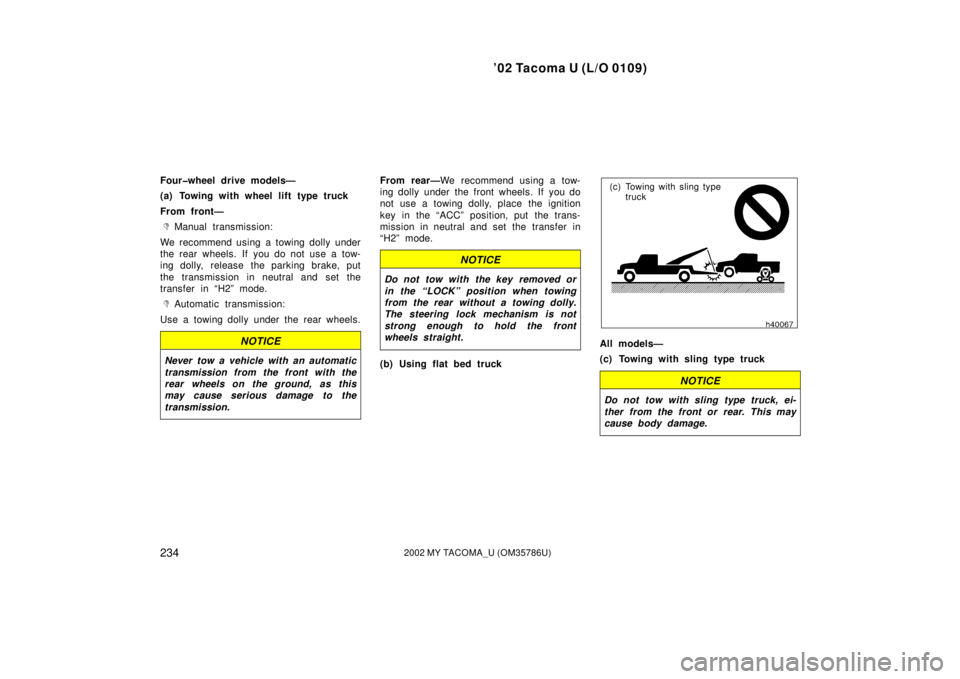
’02 Tacoma U (L/O 0109)
2342002 MY TACOMA_U (OM35786U)
Four�wheel drive models—
(a) Towing with wheel lift type truck
From front—
�Manual transmission:
We recommend using a towing dolly under
the rear wheels. If you do not use a tow-
ing dolly, release the parking brake, put
the transmission in neutral and set the
transfer in “H2” mode.
�Automatic transmission:
Use a towing dolly under the rear wheels.
NOTICE
Never tow a vehicle with an automatic
transmission from the front with the
rear wheels on the ground, as this
may cause serious damage to the
transmission.
From rear— We recommend using a tow-
ing dolly under the front wheels. If you do
not use a towing dolly, place the ignition
key in the “ACC” position, put the trans-
mission in neutral and set the transfer in
“H2” mode.
NOTICE
Do not tow with the key removed or
in the “LOCK” position when towing
from the rear without a towing dolly.
The steering lock mechanism is not
strong enough to hold the front
wheels straight.
(b) Using flat bed truck
(c) Towing with sling type truck
All models—
(c) Towing with sling type truck
NOTICE
Do not tow with sling type truck, ei-
ther from the front or rear. This may
cause body damage.
Page 242 of 308
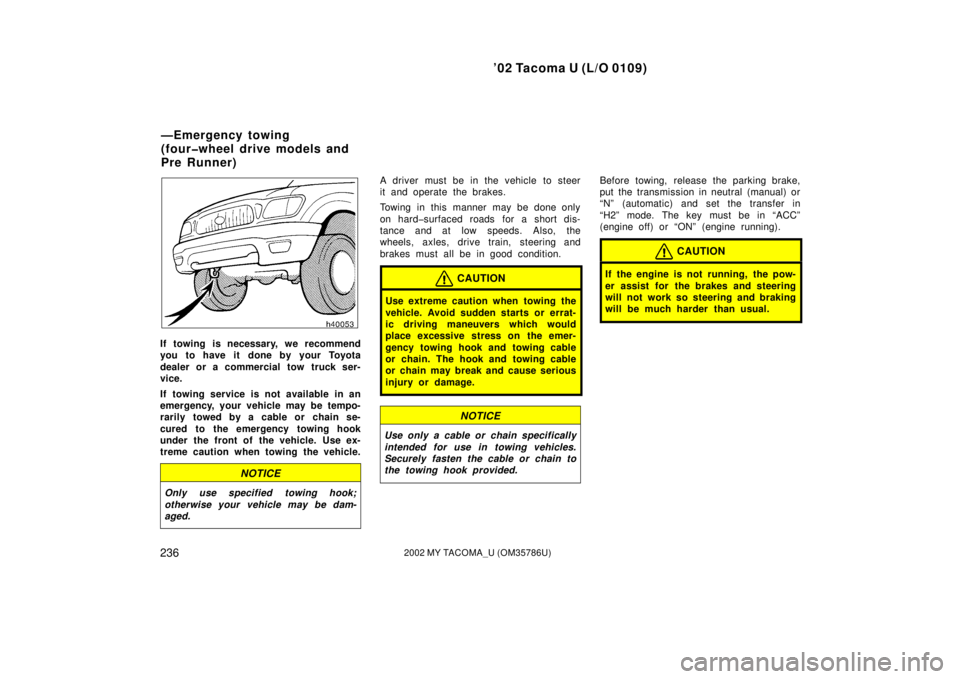
’02 Tacoma U (L/O 0109)
2362002 MY TACOMA_U (OM35786U)
If towing is necessary, we recommend
you to have it done by your Toyota
dealer or a commercial tow truck ser-
vice.
If towing service is not available in an
emergency, your vehicle may be tempo-
rarily towed by a cable or chain se-
cured to the emergency towing hook
under the front of the vehicle. Use ex-
treme caution when towing the vehicle.
NOTICE
Only use specified towing hook;
otherwise your vehicle may be dam-
aged.
A driver must be in the vehicle to steer
it and operate the brakes.
Towing in this manner may be done only
on hard�surfaced roads for a short dis-
tance and at low speeds. Also, the
wheels, axles, drive train, steering and
brakes must all be in good condition.
CAUTION
Use extreme caution when towing the
vehicle. Avoid sudden starts or errat-
ic driving maneuvers which would
place excessive stress on the emer-
gency towing hook and towing cable
or chain. The hook and towing cable
or chain may break and cause serious
injury or damage.
NOTICE
Use only a cable or chain specifically
intended for use in towing vehicles.
Securely fasten the cable or chain to
the towing hook provided.
Before towing, release the parking brake,
put the transmission in neutral (manual) or
“N” (automatic) and set the transfer in
“H2” mode. The key must be in “ACC”
(engine off) or “ON” (engine running).
CAUTION
If the engine is not running, the pow-
er assist for the brakes and steering
will not work so steering and braking
will be much harder than usual.
—Emergency towing
(four�wheel drive models and
Pre Runner)
Page 288 of 308
’02 Tacoma U (L/O 0109)
2822002 MY TACOMA_U (OM35786U)
Dimensions
Regular cab models Xtra�cab models
Overall length
Overall height
∗ 8
Front tread
Rear tread Overall width
Wheelbase 4540 (178.7)
∗
1
4685 (184.4)∗25010 (197.2)∗1
5155 (203.0)∗2
1690 (66.5)
1765 (69.5)∗3, 41690 (66.5)
1625 (64.0)
∗4, 6
1615 (63.6)∗5, 6
1620 (63.8)∗4, 7
1630 (64.2)∗5, 7
3095 (121.9)
1450 (57.1)
1455 (57.3)
1455 (57.3) 1450 (57.1)
2625 (103.3) 1590 (62.5)
∗
3, 4
1605 (63.2)∗4
1615 (63.6)∗5
∗ 1
: Without rear step bumper∗2: With rear step bumper∗3: With 5VZ�FE engine∗4: With P235/55R16 tires∗5: With P205/75R15 tires∗6: With automatic transmission∗7: With manual transmission∗8: Unladen vehicle
TWO�WHEEL DRIVE MODELS EXCEPT PRE RUNNER mm (in.)
Page 290 of 308
’02 Tacoma U (L/O 0109)
2842002 MY TACOMA_U (OM35786U)
Without off�road packagekg (lb.)
Two�wheel drive models
2RZ�FE engine
Regular cabManual transmission680 (1500)
Automatic transmission671 (1480)
Xtra�cabManual transmission703 (1550)
Automatic transmission694 (1530)
5VZ�FE engineXtra�cabManual transmission623 (1375)
Four�wheel drive models
3RZ�FE engine
Regular cabManual transmission821 (1810)
Automatic transmission807 (1780)
Xtra�cabManual transmission739 (1630)
Automatic transmission725 (1600)
5VZ�FE engineXtra�cabManual transmission718 (1585)
Automatic transmission707 (1560)
Double cabAutomatic transmission632 (1395)
Pre Runner
3RZ�FE engine
Regular cabAutomatic transmission909 (2005)
Xtra�cabAutomatic transmission830 (1830)
Double cabAutomatic transmission757 (1670)
5VZ�FE engineXtra�cabAutomatic transmission791 (1745)
Double cabAutomatic transmission737 (1625)
Payload∗
Page 291 of 308
’02 Tacoma U (L/O 0109)
2852002 MY TACOMA_U (OM35786U)
With off�road packagekg (lb.)
Four�wheel drive models
3RZ�FE engineXtra�cabManual transmission716 (1580)
5VZ�FE engineXtra�cabManual transmission696 (1535)
Automatic transmission684 (1510)
Double cabAutomatic transmission603 (1330)
Pre Runner
3RZ�FE engineXtra�cabAutomatic transmission814 (1795)
Double cabAutomatic transmission734 (1620)
5VZ�FE engineXtra�cabAutomatic transmission768 (1695)
Double cabAutomatic transmission707 (1560)
∗: Occupants + luggage